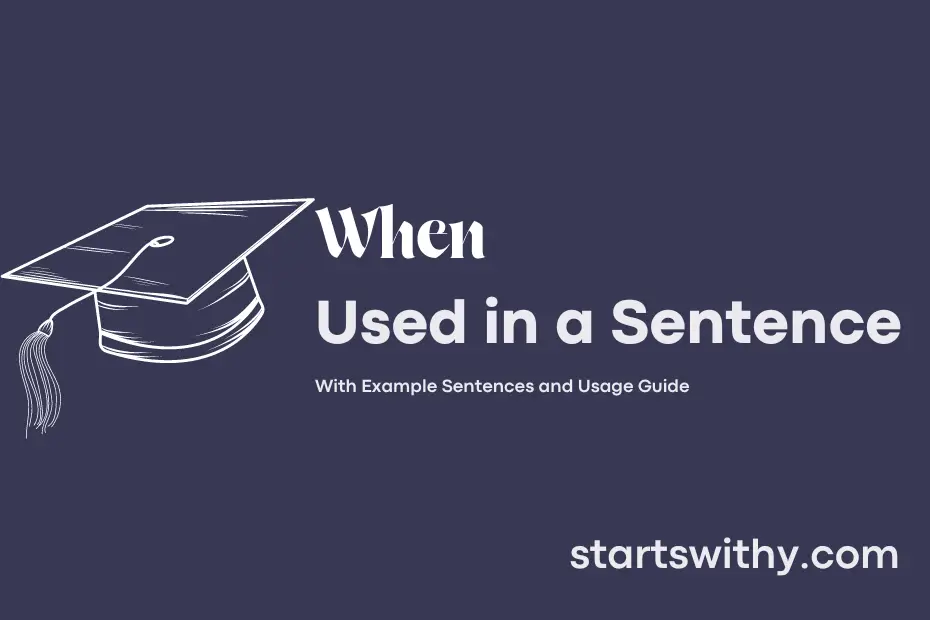Ever found yourself wondering how to properly use the word “when” in a sentence? Look no further for clarification on this common conjunction. “When” is a versatile word that is used to indicate a specific time or circumstance in a sentence.
When used in a sentence, “when” serves as a connector between two clauses to show the relationship between actions or events in relation to time. It can also introduce a condition or a specific point in time that is being referenced.
7 Examples Of When Used In a Sentence For Kids
- When the sun shines, it is daytime.
- I am happy when I see colorful balloons.
- We play outside when the weather is nice.
- When I eat my vegetables, I grow big and strong.
- When I brush my teeth, my smile looks bright.
- I say thank you when someone helps me.
- The stars come out when the sky turns dark.
14 Sentences with When Examples
- When the exam date is approaching, it’s important to create a study schedule.
- During college festivals, students often face a dilemma when they have to choose between attending events or studying.
- When deadline pressure kicks in, time management becomes crucial for juggling assignments and extracurricular activities.
- It’s common for students to feel overwhelmed when they have back-to-back lectures and seminars.
- When preparing for group projects, effective communication among team members is essential.
- When studying for competitive exams, creating a revision timetable can help manage the vast syllabus effectively.
- When attending campus placements, it’s important to make a good impression on recruiters.
- Procrastination often leads to stress when deadlines are looming.
- When searching for internships, networking with professionals in the field can open up opportunities.
- When facing academic challenges, seeking help from professors or academic advisors can provide guidance.
- When preparing for presentations, practicing in front of a mirror can help boost confidence.
- When joining college clubs or societies, students can enhance their overall college experience.
- When hosting a college event, coordinating with team members is crucial for its success.
- When applying for scholarships, meeting the eligibility criteria is essential for consideration.
How To Use When in Sentences?
When is used as a subordinating conjunction to introduce a time-related clause in a sentence. It is a helpful word to indicate the timing or sequence of events.
To use when in a sentence, simply place it before a dependent clause that provides additional information about the timing of an action or event. For example, “I will call you when I arrive home.” In this sentence, the dependent clause “I arrive home” provides more details on when the action of calling will take place.
Remember that when is often used to connect two actions or events that are related to each other in terms of time. It can indicate the beginning, duration, or ending of an activity. For example, “She always sings loudly when she is happy.” Here, the action of singing loudly is connected to the state of being happy.
Additionally, when can be used with various verb tenses and in different sentence structures. Practice using when with past, present, and future actions to become more comfortable with its usage.
In summary, using when in a sentence involves connecting two ideas related to time. By mastering the use of when as a subordinating conjunction, you can make your writing more precise and descriptive.
Conclusion
In conclusion, the word “when” is often used to indicate a specific time or condition in a sentence. It is crucial for conveying the timeline, sequence of events, or cause and effect relationships in a clear and structured manner. From asking questions about time to describing simultaneous actions, “when” plays a key role in forming grammatically correct and meaningful sentences.
By understanding how to use “when” effectively, speakers and writers can convey information accurately and with precision. Whether used to discuss past events, present situations, or future plans, mastering the usage of “when” is essential for effective communication. Its versatile nature allows for the creation of sentences that are coherent, logical, and conducive to conveying information in a straightforward manner.



